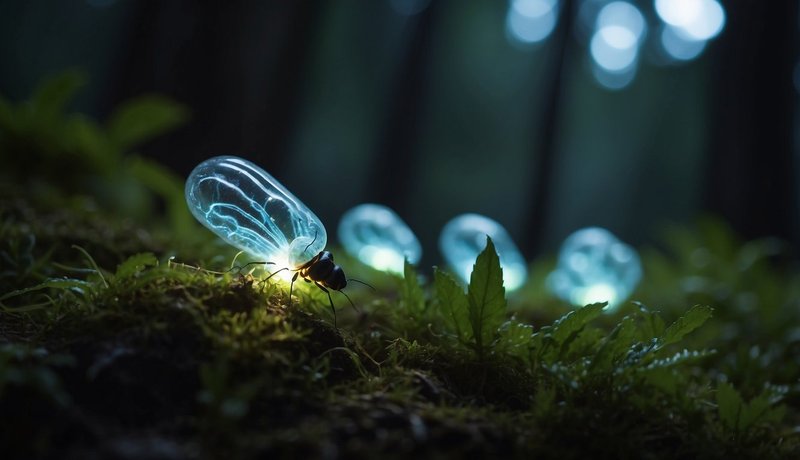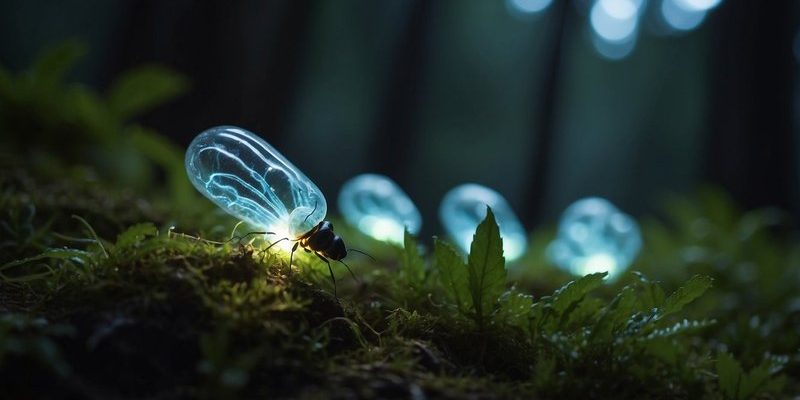
Glow worms can be found in various places around the world, but they’re particularly common in places like New Zealand and Australia. They’re not actually worms, but rather the larval stage of certain flies, like the *Lampyridae* family. When you see them glowing, it’s like they’re sending a beacon into the night—an invitation or a warning, all wrapped up in their soft, mesmerizing luminescence. Let’s unravel the mystery behind how glow worms communicate using these captivating light patterns.
What Are Glow Worms?
Before we dig deeper into how glow worms communicate, let’s get familiar with what they are. Glow worms belong to different species, but most people are referring to larvae of the *Arachnocampa* genus when they mention them. These little guys start their lives as eggs, then hatch into larvae that glow brightly. It’s almost like they’ve got their own built-in LED lights!
The glow comes from a chemical reaction that occurs in their bodies, where oxygen combines with a special light-emitting protein. They use this glow for a couple of reasons: to attract prey and, importantly, to communicate with one another. Just think of it like sending a text message: the glow is the message, and it’s all about timing and patterns!
Interestingly, the glow is usually bluish-green, which is best seen in dark environments. So, don’t expect to spot them shining brightly in the daylight. The darkness helps their light stand out—this is crucial for their communication methods.
How Do Glow Worms Use Light to Communicate?
So, here’s the thing: glow worms don’t chat like we do. Instead, they communicate through a series of light patterns. Picture a traffic light—red, yellow, green—each color signals a different action. Similarly, glow worms can signal different messages by changing the intensity and frequency of their glow.
When a glow worm lights up, it’s often trying to attract mates or discourage competitors. Male glow worms may flicker their light at specific intervals to woo potential mates, almost like a romantic dance. On the flip side, females might send out consistent patterns to let males know they’re available.
Moreover, this communication isn’t random. It’s carefully synchronized. When one glow worm emits light, it can influence others around it to join in. It’s like a concert where all the musicians are in sync, creating a beautiful symphony of light. This synchronization is crucial during mating season, as it helps increase their chances of reproduction.
The Science of Bioluminescence
Bioluminescence, the process that powers the glow worms’ light, is truly captivating. It involves a chemical reaction between a light-emitting molecule called luciferin and an enzyme called luciferase. When these two substances react, they produce light. It’s like a magic trick, but instead of a wand, they have their own special chemicals.
In glow worms, this bioluminescence serves several essential functions. It not only attracts mates but also lures in unsuspecting prey, usually small insects drawn to the glow. Once the insects get close enough, the glow worm snags them using sticky silk threads that resemble spider webs. So, their glow is both a lure and a means of communication—talk about multitasking!
This bioluminescent ability is not unique to glow worms. Various other organisms, like certain species of fungi and jellyfish, also produce light. Each has adapted its glow for specific purposes, showing how nature has so many creative ways to use this fascinating science.
The Role of Light Patterns in Mating
When it comes to reproduction, light patterns play a vital role for glow worms. Females tend to remain stationary in their nests, emitting a steady glow to attract males. It’s like holding up a neon sign saying, “Hey, I’m here! Come and find me!” The males, with their flickering lights, respond to this steady signal.
The attraction isn’t purely based on brightness; it’s about rhythm and pattern too. Males must time their flashes to match those of the females. If they flash too quickly or too slowly, the male might miss out on a mate. This intricate dance of light is crucial for ensuring their species continues to thrive.
Interestingly, researchers have found that the size and intensity of the glow can indicate a female’s health and reproductive status. Brighter glows from females suggest they are healthier and more likely to produce viable eggs. This means that males must pay close attention—not just to the glow itself, but to how it changes over time.
Environmental Factors and Their Effects
Like many creatures, glow worms are influenced by their surroundings. Their glow can be affected by various environmental factors, including temperature, humidity, and even light pollution. For instance, if the environment is too bright, it can overshadow their glow, making communication difficult.
Temperature and humidity play crucial roles in their life cycle too. Glow worms thrive in moist, dark environments, so they tend to flourish in caves or areas with dense vegetation. Unfortunately, if these habitats are disrupted—due to climate change or human activity—it can impact their ability to communicate effectively.
Light pollution can drastically alter how glow worms interact. If city lights drown out their natural glow, they may struggle to find mates or communicate with each other. So, protecting their habitats and minimizing artificial light can help keep their enchanting light-show alive.
How Humans Are Impacting Glow Worm Communication
While glow worms are beautiful and captivating, they face threats from human activities. Urban development, pollution, and habitat destruction are significant challenges they must navigate. The introduction of artificial light in natural areas can disrupt their glowing communication.
To ensure these amazing creatures continue to thrive, it’s essential for us to be aware of our impact. Simple actions like reducing light pollution and protecting natural habitats can make a big difference. For instance, using shades or curtains at night can help minimize light spilling into natural areas where glow worms reside.
Conservation efforts are taking place in various regions, focusing on habitat protection and public awareness. By educating ourselves and others about the importance of these creatures, we can make a positive impact on their future.
Glow worms offer a mesmerizing glimpse into the wonders of nature. Their ability to communicate through light patterns is not just beautiful but essential for their survival. From attracting mates to luring prey, these tiny creatures use their glow in surprisingly complex ways.
Understanding how glow worms communicate helps us appreciate the delicate balance of ecosystems and the importance of protecting natural habitats. As we learn more about these glowing wonders, let’s remember to tread lightly on their environments and support efforts to keep their dance of light alive for generations to come.

